Apple Watch vs Moto 360: Which beautiful smartwatch is top?
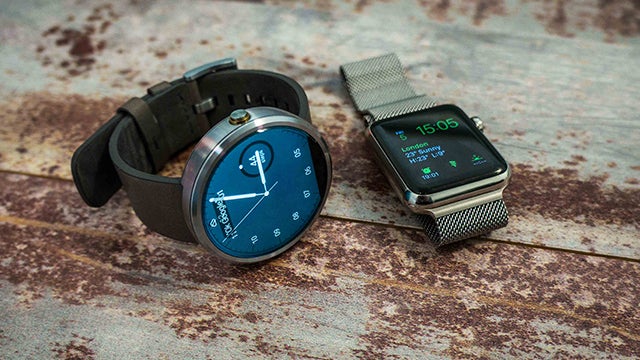
We’ve done the reviews, but what is it actually like just living with Motorola and Apple’s smartwatches? Here’s our thoughts
Smartwatches are well and truly here. Are they in it for the long haul? We’ll have to wait and see, but one thing we do know already is that now Apple has marched on to the scene, wearables are finally getting mainstream exposure.
But what of Android Wear? Especially, how does one of our favourite Wear-toting wrist-fancies, the Moto 360, shape up against Cupertino’s much-hyped, yet slightly disappointing, first wearable? Let’s put them head to head in the real world to see which comes out king.
To get the best look at how both these devices perform, we decided to wear them both at the same time – yes, we risked looking like complete fools over the course of a week, all for your benefit. We hit the gym, downloaded some apps (many of which we then deleted), put both Android Wear and watchOS through their paces, spent a good few hours thinking we were actually James Bond and just generally living in the future.
Which came out on top? Read on to find out. (also read our guide to the best smartwatches).
Working Out
With the Watch, Apple made a big play for the fitness market. It was hoping to go after those people who were torn between picking up a smartwatch, a fitness band and even a sports watch. Straight out of the box you’ll find two dedicated fitness apps – Activity and Workout, with each being aimed at a different audience. You’ve got Activity for your basic step tracking and general day-to-day movement, while Workout is more of a gym buddy and lets you track particular performance when you’re running or cycling.
SEE ALSO: Apple Watch: The Trusted Reviews verdict
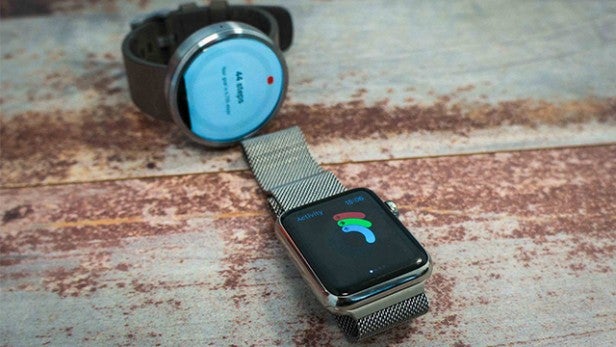
Google has also gone after the fitness crowd with its Android Wear platform, releasing the Google Fit service that works in tandem with its wearable OS and your phone. Fit works in a similar way to Activity on the Apple Watch, keeping an eye on your steps, calories and overall distance moved throughout the day.
So, are either worth ditching your Fitbit or running watch for? Well, no. But the groundwork is there.
We used both devices in the gym, replacing our normal running watch, and while both worked they lagged in certain areas. The heart-rate monitor of both watches were spewing out strange and often completely wrong results. We were actually dead? We really hoped not. Both the Apple Watch and the Moto 360 suffered with inconsistencies in this department, made even more obvious when put up against a dedicated running watch. They both took a while to actually pick up a reading, and even longer to decide on one that we felt confident might be accurate. If you’re serious about your stats, neither of these will cut the mustard for you.
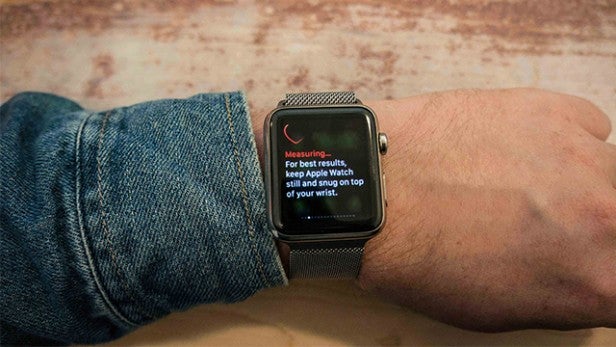
General movement tracking on both is good, though. At the end of the day we recorded similar results with both and then compared them to a Misfit Shine we had in our pocket. They all matched up pretty well. Unlike most dedicated trackers, there isn’t any sleep tracking at play here – probably because you really should be juicing these up while you’re deep in slumber.
Getting noticed
Everyone will have a different opinion on this, but we think the Apple Watch and Moto 360 are two of the slickest, best-looking smartwatches on the market today. Neither, unless you’ve somehow splashed out £13,500 on that gold Apple Watch Edition, are overly flashy or try to mimic the look of a traditional watch – more than can be said for the LG Watch Urbane.
Wearing both devices is a pleasant experience – they’re comfy and fit well. The default Moto 360 strap is a little stiff, though others are available, and the Sport band we used on the Apple Watch was much nicer than we expected. it’s soft, matte and manages to avoid catching hairs. Though we can’t say the same for the Milanese Loop bracelet.
The biggest difference between the two is the watch face shape. The Moto 360 has a round face, while Apple goes with a square one. It’s true, the Moto 360 does look a tad more ‘watchlike’ in the traditional sense, but from someone who’s been wearing a digital Casio for a number of years, the square face feels much more familiar.
SEE ALSO: iPhone 6 vs iPhone 5S
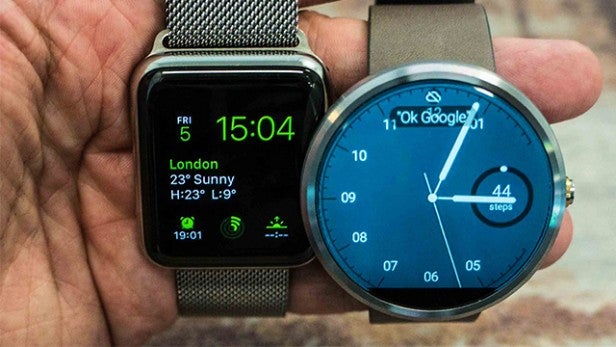
The Moto 360 is the larger of the two, even compared the bigger 42mm Apple Watch we were using, but not by so much that it feels unwieldily on our wrist. In fact, the Apple Watch was much smaller than we were expecting, which was a plus for us, but it might actually be too small for those with larger hands than ours. The Apple Watch could do with protruding a little less from the wrist, though as with all Apple products we’ll undoubtedly see its successor shed a few millimetres.
Even though we were rocking a dual-smartwatch combo, we never felt like either watch was catching undue attention. This is most definitely a plus. The Apple Watch is the sleeker of the two, and the vast array of options and bands help to personalise it to some degree, but it doesn’t completely dominate the Moto 360 when it comes to design.
Getting used to the OS
Both of these wearables take a very different approach to how they want you to use the operating system. But what better way to see which works better on a day-to-day basis than putting them through their paces.
Android Wear is, at its core, very basic. It’s a stream of scrollable Google Now cards, a place for your notifications and the home to some simple apps. An upcoming update – it’s already hit some G Watch Rs but not our Moto 360 – will add a dedicated app launcher and emoji drawing. Most of the navigation is meant to be done through voice: saying ‘OK, Google Now app play some music’ will launch the Music app. It’s meant to help you spend less time scrolling through menus on that tiny display, and it works very well.
SEE ALSO: Best Apple Watch apps

Siri does a similar thing on the Apple Watch, and again works fantastically, but there’s much more of a focus in watchOS on it being a more complete operating system. This is shown by the app-based launcher, the much longer settings panel and just the sheer amount of things Apple has packed into it. watchOS feels very much like iOS shrunk down, while Android Wear feels like an extension of the regular Android phone platform.
We also found watchOS was quite hard to get to grips with, while Android Wear on the Moto 360 was far more intuitive. You haven’t got to learn when you can and can’t Force Touch, when you shouldn’t use the Digital Crown, or why Apple ever felt it was a good idea to dedicate a whole button to launching a simple list of your favourite contacts.
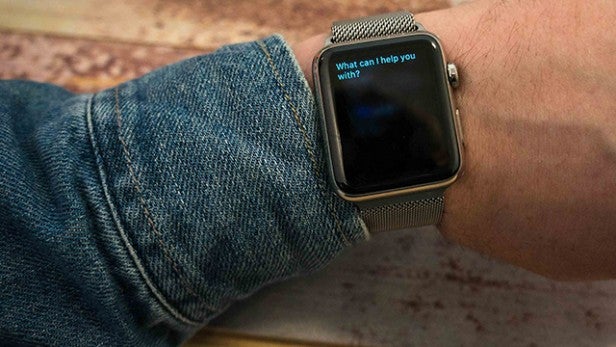
The Google Now cards are, if you’ve used the system for a while and it’s learned your habits, a winner. When we approach a bus stop a card will pop up showing upcoming departures – that just makes sense. That’s what these devices should be doing, showing us important information when we need it. We’ve got our phones for everything else.
Google has the better operating system – for now, anyway. It’s easier to use, makes more sense on the wrist and doesn’t try to cram an entire phone feature set down into a 1-inch display.
Going the distance
Battery life has been the biggest talking point since we first buckled a smartwatch to our wrist. We’ve been so used to leaving our watch tied to our arm for years at a time without needing to even think about juicing it up that the thought of having another device that’d need a nightly charge had us all a bit down.
But by somewhat changing our routines we’ve managed to cope with keeping both the Moto 360 and Apple Watch suitably juiced up.
Tim Cook noted that the Apple Watch would need charging every night, but throughout our testing we’ve found that we can stretch this out a little, though we never quite managed to get two days out of it. The same goes for the Moto 360, which has enough battery capacity to easily make it through day one, but come lunchtime of day two you might be wishing you stuck it on the charger overnight.
SEE ALSO: Moto 360 review
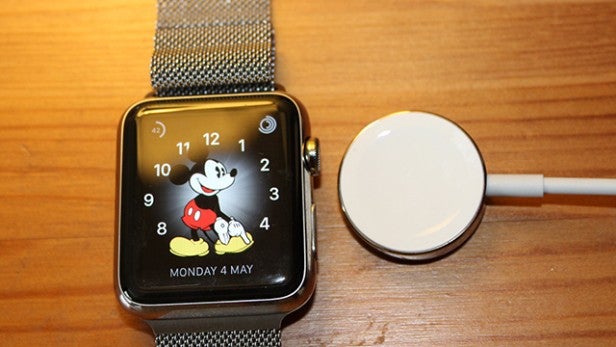
The nifty Power Reserve mode on the Apple Watch is a handy feature, turning off all non-essential functionality when the battery drops into the red. There isn’t really anything similar to this, yet, in Android Wear on the Moto 360.
One reason why we’ve managed to adapt, to a certain degree, to the poor battery life of these smartwatch pioneers is down to the easy and quick charging solutions both Motorola and Apple have come up with. The magnetic MagSafe charger snaps on to the base of the Watch, while the Qi tech inside the 360 lets it power up through any compatible wireless pad. Motorola also included a nice charging dock with the 360 – something we would’ve liked to see Apple include too, especially for the price.
SEE ALSO: How does the Apple Watch shape up in a race across London?
Getting stuff done
Even though Android Wear’s been around a lot longer than watchOS, the app situation is currently leaning heavily in favour of the latter. But that doesn’t really tell the whole story, because we’ve found Android Wear app developers, on the whole, seem to understand the concept of a smartwatch more than those making them for the Apple Watch.
Let’s use the navigation apps as an example. On Android Wear you set things up on your phone and as you move you’ll receive directional hints on your wrist. Great. It’s a simple process, whereas the Apple Watch puts much more onto the device, letting you scroll around a map on the 1-inch display. We tried out a few routes and Android Wear outperformed watchOS every time. It was more reliable with instructions and, because it’s powered by Google Maps, much better at finding POI and successfully helping us reach our destination.
SEE ALSO: Apple Watch vs Pebble
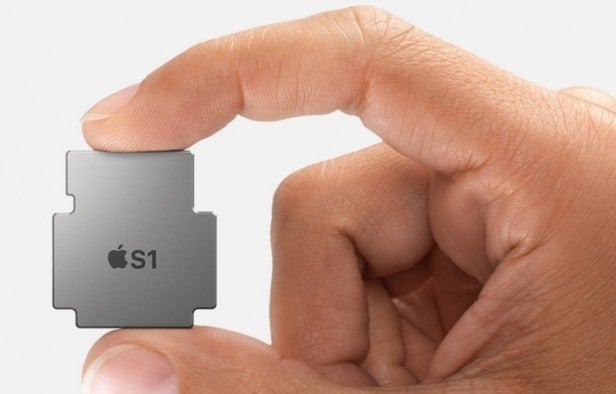
This theme runs through the Apple Watch. Apps just want to do too much. We found ourselves spending far more time than we would’ve liked scrolling and selecting options, rather than just getting stuff done. Maybe developers just need time to fully adapt to the platform, so hopefully this sort of thing will gradually get ironed out.
Android Wear has fewer apps, yet some are pretty useful. Weather Timeline gives you much more detailed and useful weather cards than the regular Google alerts, while PocketCasts lets you see what’s playing next in your queue. They’re simple, but that’s important.
One thing that Apple has up its sleeve is Glances. These are widgets that show bitesize pieces of information, which you can scroll through directly from the homescreen. They’re more comparable to the apps on Android Wear, showing you only the vital bits of information – the currently playing song for example, or your heart rate.
Staying in contact
Another area smartwatches are hoping to make a play for is taking the place of our phones for short bursts of communication. We’re not talking about tapping out emails on a tiny on-screen keyboard here – both the Moto 360 and Apple Watch have some nice ways of shooting off quick messages without pulling out your phone.
The best we found was Digital Touch on the Apple Watch. This slightly weird function lets you draw messages (or ahem, drawings) and ping them off to other Watch wearers. They will then appear, in a floaty, wispy font, on the other device before disappearing again. It’s meant, we’re sure, to be used to send loving messages to spouses, but we ended up utilising it for far more childish means. There’s also some animated emoji you can send too, but they’re a bit weird.
Android Wear has hit back with an emoji drawing tool, though this is part of an update that hasn’t hit the Moto 360 yet, so we couldn’t test it out. The premise is simple, though: draw the outline of your favourite face and it’ll translate your scribble and send out the results. The plus this has over the Apple Watch is that it’s not OS restrictive and can be sent to anyone.
SEE ALSO: Best Apple Watch apps
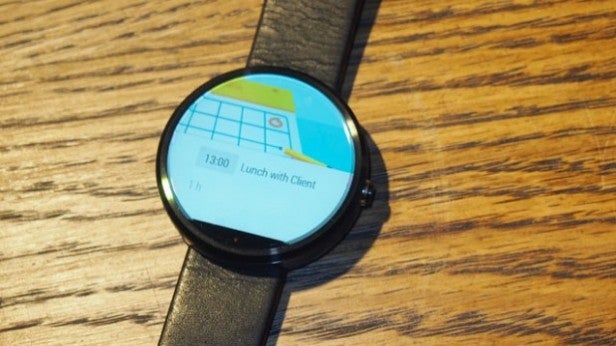
Both let you shoot off canned replies to incoming texts, though the Apple Watch also lets you send specific replies to certain messages. For example: you receive a text that says, ‘Shall I get coffee or tea?’ and you’ll be able to quickly send a response saying either ‘coffee’ or ‘tea’. If you wanted hot chocolate, you’re out of luck. They’re fairly handy, but so abrupt and a tad rude – give us ‘tea, please’ – that we used them only very sparingly.
You can also knock out messages via voice. This was the best way on both platforms, with both watches catching our voices accurately and quickly. It’s not as easy as entering the text by keyboard and best not used in public, but it’s cool nonetheless.
How did they fare?
Smartwatches are new, which means that no one has quite yet managed to work out exactly what they need to do, except show us our incoming notifications. This has led to Apple and Android taking fairly different directions so far. Android Wear is simple, while Apple’s watchOS is bigger, more app focused and harder to use.
Probably none of you will, or should, wear both watches at the same time – not least because you’d also have to wield dual phones – but it’s helped us see which platform we feel most at home with. Android Wear seems to be the current best, mainly because it ‘gets’ the idea of a smartwatch better than watchOS on Apple Watch. There’s less navigation of, and interaction with, the watch – information we wanted to see was just there, in front of us.
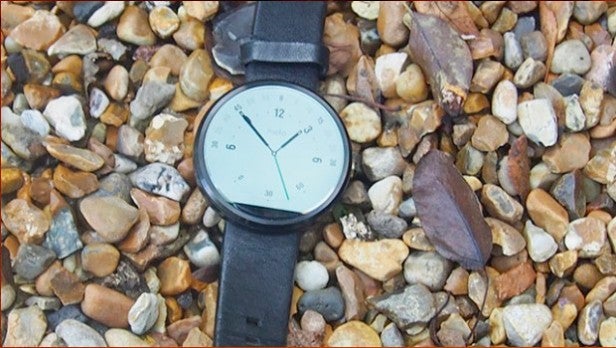
Both the Moto 360 and Apple Watch have a long way to go if they want to become an accessory for those who really care about tracking their fitness levels. Right now they’re too inaccurate to really be worthwhile alternatives to mega running watches from the likes of Polar.
Design-wise, they both have pros and cons, as with anything, though for us they’re amongst the best you can get. The Apple Watch has the customisations, the Moto 360 has that distinctive circular clock face and they both feel nice when worn.
It’s always going to come down to what phone you’ve got – until Google manages to somehow get Android Wear into the App Store, at least. But it’s good to know that even in the very early lifecycle of a product category there are some half-decent choices out there.


